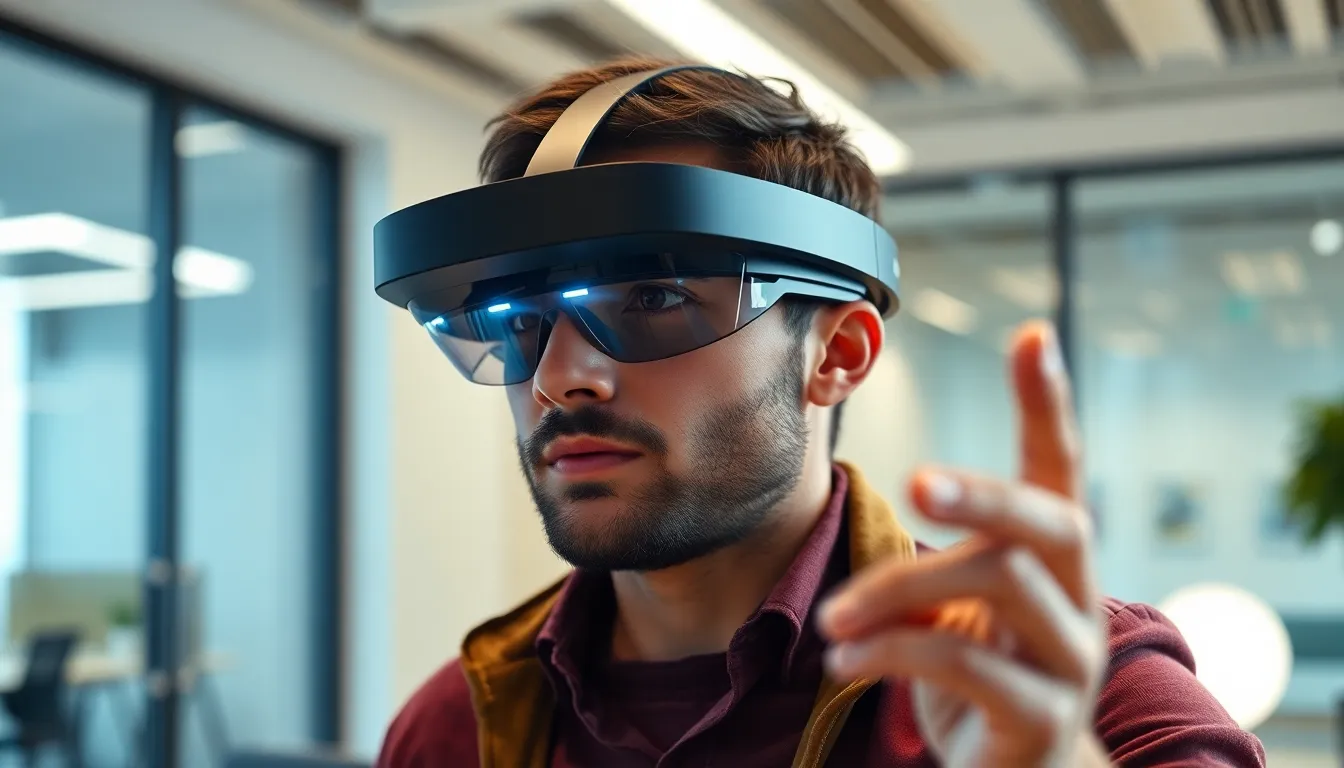The augmented reality ecosystem is rapidly transforming how people interact with the digital and physical worlds. With the rise of smart devices and advanced software, AR has moved beyond gaming and entertainment, finding applications in education, healthcare, and retail. This innovative technology overlays digital information onto the real world, enhancing user experiences and creating new opportunities for engagement.
As industries embrace AR, understanding its ecosystem becomes crucial. It encompasses hardware like AR glasses and smartphones, software development tools, and content creation platforms. Each component plays a vital role in delivering immersive experiences that captivate users. By exploring this dynamic landscape, businesses and developers can harness the full potential of augmented reality, driving growth and innovation in an increasingly digital age.
Table of Contents
ToggleOverview of Augmented Reality Ecosystem
The augmented reality (AR) ecosystem encompasses several components that work together to create immersive digital experiences. This ecosystem includes:
- Hardware
- AR devices like glasses and smartphones serve as platforms for displaying augmented content. Popular examples include Microsoft HoloLens and Google Glass.
- Sensors and cameras integrated into these devices collect real-time data, enhancing the accuracy of overlays.
- Software
- AR software development kits (SDKs) allow developers to create AR applications. Examples include ARKit for iOS and ARCore for Android.
- Content creation tools support the development of 3D models and interactive elements. Programs like Unity and Vuforia enable complex visualizations.
- Content
- Engaging content forms the core of AR experiences. This includes educational apps, interactive marketing campaigns, and training simulations.
- Businesses leverage AR to personalize user interactions by integrating branded experiences within their applications.
- User Experience
- The effectiveness of AR solutions depends on seamless user interfaces. Intuitive controls enhance user engagement and satisfaction.
- Feedback mechanisms allow users to interact with virtual elements naturally, improving the overall experience.
- Ecosystem Support
- Partnerships between hardware manufacturers and software developers drive AR innovation. Collaborations often lead to more refined products and applications.
- Industry associations and standards bodies help establish common frameworks that improve device interoperability and application standardization.
The continuous evolution of the AR ecosystem invites exploration and investment. Understanding these core components enables businesses and developers to harness AR’s potential effectively while anticipating future advancements.
Key Components of Augmented Reality Ecosystem

The augmented reality ecosystem consists of critical elements essential for delivering immersive experiences. Understanding these components—hardware and software—plays a vital role in navigating the AR landscape.
Hardware Requirements
Hardware components serve as the foundation of the AR ecosystem. Devices such as AR glasses and smartphones are integral, enabling users to interact with augmented content seamlessly. Notable hardware examples include:
- Microsoft HoloLens: A mixed-reality headset featuring advanced sensors and displays, allowing users to experience 3D holographic content.
- Google Glass: A smart eyewear device that overlays information in the user’s field of vision, promoting hands-free interactions.
- Smartphones: Mobile devices equipped with sensors and AR capabilities, supporting applications that utilize camera input to integrate digital elements into the real world.
These devices collectively enhance data collection and user experiences by providing sensors that capture environmental information accurately.
Software Platforms
Software platforms drive the creation and implementation of AR applications. They include development kits and content creation tools that simplify the AR production process. Key software platforms feature:
- ARKit: Apple’s framework for developers, providing tools for building AR applications on iOS devices with features like motion tracking and environment mapping.
- ARCore: Google’s AR platform for Android, offering capabilities for creating engaging experiences through environmental understanding and light estimation.
- Unity: A widely-used game engine that supports AR development, enabling developers to create rich interactive content with extensive documentation and community support.
- Vuforia: A tool that specializes in image recognition and tracking, allowing developers to build AR applications that recognize and augment physical objects.
These platforms enhance collaboration between hardware and software, fostering innovation within the AR ecosystem.
Applications of Augmented Reality Ecosystem
Augmented reality (AR) significantly impacts various industries, enhancing user experiences through interactive and immersive applications. The following sections explore key industries leveraging AR and specific use cases.
Industries Leveraging Augmented Reality
- Healthcare: AR enhances medical training through simulations and assists in surgeries by overlaying critical information on patients during procedures. It facilitates visualization of complex anatomical structures.
- Education: AR transforms learning experiences, providing interactive content that enhances comprehension. It enables virtual field trips and dynamic lessons, engaging students through gamified elements.
- Retail: AR improves the shopping experience by allowing customers to visualize products in their environment before purchase. Virtual fitting rooms and furniture placement applications are examples of this technology in action.
- Manufacturing: AR aids assembly and maintenance processes by providing workers with real-time instructions and visual overlays. This technology reduces errors and increases efficiency on the production floor.
- Real Estate: AR offers virtual property tours and 3D visualizations, enabling potential buyers to explore properties without physical visits. This functionality enhances marketing strategies for real estate agents.
Use Cases and Examples
- IKEA Place App: This mobile application allows users to visualize how furniture fits and looks in their homes using AR technology, streamlining the decision-making process.
- Google Lens: Google Lens utilizes AR to provide information about objects in real-time. Users can point their cameras at landmarks, products, or text to receive instant data and translations.
- Microsoft HoloLens in Healthcare: Surgeons use Microsoft HoloLens for overlaying vital statistics and imaging data during operations, boosting precision and patient outcomes.
- Pokemon GO: This popular mobile game exemplifies AR in entertainment by blending virtual creatures with real-world environments, encouraging exploration and physical activity.
- Augmented Reality in Training: Companies utilize AR for employee training by simulating real-world scenarios, enabling hands-on practice and reducing training costs while enhancing retention.
- Visitor Experience in Museums: Museums implement AR applications to enrich exhibits with interactive displays and narratives, improving visitor engagement and education.
These applications demonstrate AR’s diverse impact across sectors, revolutionizing user interaction and experiences.
Future Trends in Augmented Reality Ecosystem
Augmented reality (AR) continues to evolve rapidly, fostering innovations that shape its ecosystem. Emerging trends in AR signal significant advancements across several sectors.
- 5G Integration
5G technology enhances AR experiences by providing faster data transfer and lower latency. This advancement enables real-time interactions and smoother applications, particularly in gaming and remote collaboration.
AR glasses and smart lenses are becoming more sophisticated. Devices like the Magic Leap 2 and developing iterations of Microsoft HoloLens will deliver lighter, more comfortable options, promoting wider adoption in everyday settings.
- Artificial Intelligence (AI) Utilization
AI algorithms will improve AR applications by enabling more accurate object recognition and user context awareness. Companies like Apple and Google are implementing AI to tailor AR experiences, enhancing user engagement.
- Collaborative Environments
AR platforms will increasingly support remote collaboration, allowing teams to interact in shared virtual spaces. Applications will leverage AR to enhance communication and productivity in industries such as engineering and design.
- Improved Content Creation Tools
Evolving content creation tools will simplify AR development for creators, democratizing access. Enhanced platforms like Unity and Adobe Aero are making it easier for developers to produce high-quality AR content.
- Healthcare Innovations
AR’s role in healthcare is expanding. Innovations include AR-assisted surgeries and remote consultations, allowing professionals to visualize critical information during procedures and support telehealth initiatives.
- Smart Retail Experiences
Retailers are employing AR to create immersive shopping environments. Virtual fitting rooms and interactive product displays allow consumers to experience products in a personalized way, influencing purchasing decisions.
- Education Transformation
AR applications are redefining education through interactive learning experiences. Institutions are applying AR to create engaging curricula that enhance understanding in subjects like science and history.
- Standardization Efforts
Industry associations are working on establishing interoperability standards. These efforts aim to unify AR solutions, allowing for cross-platform experiences and enhancing usability across various devices.
- Sustainability Focus
Developers are emphasizing sustainability in AR projects. Eco-friendly applications aim to minimize waste and promote environmental awareness, aligning with global efforts toward sustainability.
These trends point toward a future where augmented reality becomes an integral part of daily life, influencing how individuals interact with their environments and enhancing user experiences across numerous sectors.
Challenges in Augmented Reality Ecosystem
The augmented reality ecosystem faces specific challenges that impact its growth and adoption.
Technical Limitations
Technical limitations hinder the performance and usability of AR solutions. Developers encounter issues related to device processing power, which may not efficiently handle complex AR applications. Tracking accuracy suffers in challenging environments, such as low-light or cluttered areas, affecting user experiences.
High Development Costs
High development costs present a barrier for many businesses entering the AR space. Creating effective AR applications requires specialized skills and tools, which can make the initial investment substantial. This financial hurdle limits innovation and accessibility in the ecosystem.
User Acceptance
User acceptance plays a crucial role in the success of AR technologies. Many individuals remain skeptical or unfamiliar with AR applications, leading to lower engagement rates. Additionally, privacy concerns arise from the use of camera and location data, resulting in hesitance among potential users.
Standardization Issues
Standardization issues complicate interoperability between AR devices and platforms. The lack of consistent protocols results in fragmented user experiences and challenges developers face when creating cross-platform content. Establishing unified standards is necessary to streamline integration across various devices.
Regulatory Hurdles
Regulatory hurdles pose significant challenges for AR implementation. Various industries face strict regulations concerning data privacy and security, consumer protection, and intellectual property rights. Adapting AR technologies to comply with these regulations can slow down development and deployment.
Market Competition
Intense market competition within the AR ecosystem leads to rapid technological advancements, but it also creates challenges. Companies focus on differentiation, often resulting in fragmented tools and solutions. This competition can overshadow smaller players and limit their ability to innovate.
By addressing these challenges, stakeholders can enhance the AR ecosystem, facilitating growth and expanding its applications across industries.
The augmented reality ecosystem is poised for significant growth and innovation. As it continues to bridge the gap between digital and physical worlds, AR’s applications across various industries will reshape user experiences. The collaboration between hardware and software developers is crucial for advancing this technology, while ongoing standardization efforts will enhance interoperability.
Despite challenges such as technical limitations and user acceptance, the future of AR looks promising. With the integration of AI and 5G technology, along with a focus on sustainability, AR is set to become an essential part of everyday life. As businesses and consumers embrace these advancements, augmented reality will undoubtedly redefine interactions and enhance productivity across multiple sectors.


